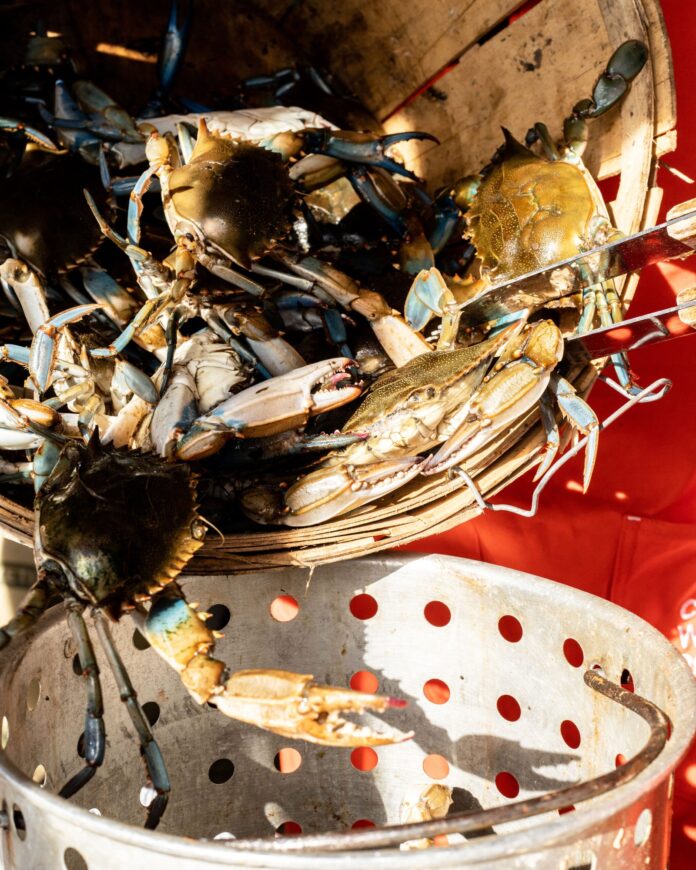There’s no better group activity than getting your hands dirty together—especially when the end results are edible. This is universally true, but what’s eaten varies by continent, country, state, city, and even neighborhood. (If you’ve ever engaged in a conversation about the color of roux for gumbo amongst New Orleanians from different sides of the river, you’ll understand: blonde versus dark roux is a hot, hot topic.) In the coastal South, these gatherings often unfold around the boiling of crustaceans, roasting of oysters, or frying of fish. What’s destined for the pot depends on the season, proximity to water, and who’s cooking. In Charleston, South Carolina, the Lowcountry boil (also known as Frogmore Stew) is king, bringing fresh shrimp and crabs to the forefront for a messy, festive feast.
Tia Clark, native Charlestonian and owner of Casual Crabbing with Tia, grew up eating blue crabs regularly with her large extended Gullah Geechee family. The Gullah Geechee community are descendants of enslaved Africans who lived and worked on the coastal Atlantic plantations, including South Carolina and the Sea Islands. Crabbing and eating crab play an essential part in Gullah Geechee culture—something Clark truly began to understand later in life after a health scare wake-up call, when she quit smoking and embraced an active lifestyle. Despite growing up in downtown Charleston, surrounded by water and seafood, Clark had never been to the beach until she was 17—and had certainly never caught a live crab. But in 2018, when she went crabbing with a cousin and caught her first crab, the experience changed her life. “After that, I just wanted to be on the water all the time,” Clark recalls. “How did I not know crabs were out here?” That fateful day set Clark on a path to starting her own business, in which she takes others onto the water and shows them the ropes, inviting them into the crabbing community.
That community is, at the end of the day, the main point of a boil. “That’s where the joy is,” says Clark, whether she’s steaming her crabs with water and light beer, or mixing up a spicy boil. “Number one, you’ve got to get a group of people ready to gather around the table, and an awesome outdoor setting,” says Clark. “That’s what it’s all about,” she adds. “Everyone being around the table together. Cracking crab is like breaking bread together.”
And when it’s time to get crackin’, Clark likes to serve her blue crabs with spicy butter, the recipe for which she won’t divulge. What she can tell us, however, is that she is a fan of the liberal application of Old Bay, a classic seafood boil component. Here’s how to throw your own Lowcountry-style seafood boil, according to Clark.
Step One: Assemble the Ingredients
If you’re Tia Clark, you’ll catch your own crabs in the waters around Charleston. If you’re not lucky enough to be in her company, head to your local seafood purveyor, or order them online. Depending on the size of the crabs, how ravenous your guests are, and how proficient they are at picking crabs, you’ll likely need four to six for each guest. If you’re serving other food, you can get away with fewer.
Step Two: Prepare the Boil
All the flavor comes from the boil, says Clark, so make sure you season heavily. Unlike flavoring a soup or stock, you generally don’t have to worry about being too liberal with spices, as guests won’t be consuming the boil liquid.
In a large metal pot with a steamer basket, add enough water to fill the pot about halfway. Add your seasonings of choice: Clark typically uses Old Bay, a cheap beer like Miller High Life (“Don’t ask why, that’s how we’ve been doing it forever,” she says), hot sauce (such as Texas Pete), and apple cider vinegar, which Clark says helps the meat separate from the shell more easily. Bring the liquid to a rolling boil.
Meanwhile, prepare the other ingredients: small red potatoes, halved corn on the cob, and andouille or other smoked sausage cut into 2-to-3-inch chunks. An unexpected, optional addition: peeled hard-boiled eggs. “Sometimes we throw eggs in there, and you’ll get hard-boiled eggs with all the spiciness of the boil in there,” says Clark. “That’s a Geechee thing.”
Step Three: Cook the Crabs
When adding ingredients to the boil, there’s a method to the madness. Items that cook longer, such as potatoes, go in first, with delicate seafood entering the mix last. Clark adds her tubers first, boiling them for 5 to 10 minutes before adding corn on the cob and sausage, which should cook for another 5 minutes or so. Then, add the crabs, boiling them until cooked through and bright red, which usually means a minimum of 15 minutes. If adding shrimp, dump those in last, then remove the entire boil basket after 2 minutes.
Step Four: Serve the Crabs
“Usually there are people gathered around the pots, and they are ready,” says Clark. “You’ve gotta ask everyone to move so you can just get to the table.” After you’ve scattered the crowd, carefully lift the basket from the boil pot and allow it to drain briefly. Pour the crabs and accouterments onto a newspaper-lined table—season liberally with more Old Bay, or your favorite seasoning. For a quicker cleanup, cover the table in burlap under the layer of newspaper—at the end of the party, roll the entire shebang up and throw it into the trash.



